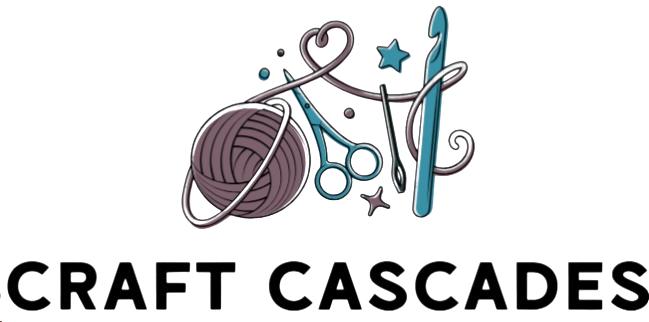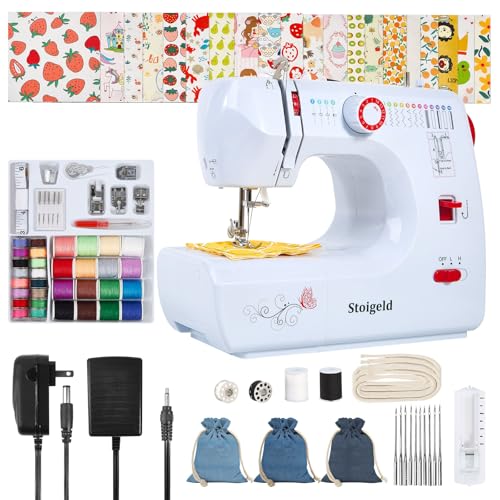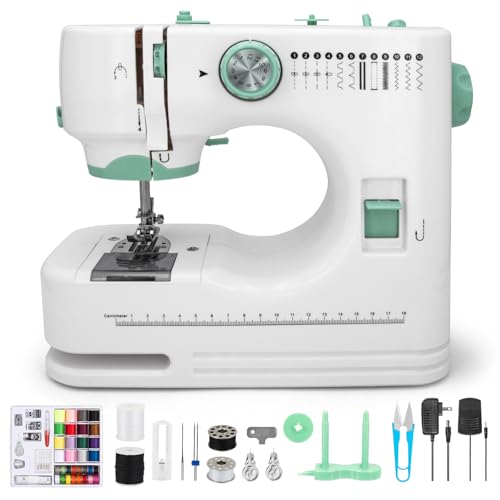You’ve got a stack of patches waiting to be attached, but your current sewing machine struggles with the multiple fabric layers. Whether you’re reinforcing work uniforms, customizing denim jackets, or running a small embroidery business, you need a machine that won’t skip stitches or break needles mid-project. The difference between a standard model and a true heavy-duty option can make or break your patch-application success.
Handheld Sewing Machine, Mini Portable Electric Sewing Machine for Beginners
If you’re new to sewing patches or need quick repairs on the go, this handheld machine delivers portability without sacrificing functionality. Its lightweight, ergonomic design makes it perfect for home use or travel. You’ll appreciate the dual power options—run it on four AA batteries or DC 6V direct current, depending on your situation. It handles various materials including jeans, T-shirts, and curtains with fast stitching capabilities. The machine arrives pre-threaded with testing fabric, so you can start working immediately. While it’s beginner-friendly, it provides enough versatility for DIY projects and encourages hands-on creativity for quick patch applications.
Best For: Beginners, travelers, and DIY enthusiasts who need a portable solution for quick sewing repairs, simple patch applications, and small projects on various fabrics.
Pros:
- Dual power options (4 AA batteries or DC 6V) provide flexibility for use at home or while traveling
- Lightweight and compact design makes it highly portable and easy to store
- Arrives pre-threaded with testing fabric for immediate use right out of the box
Cons:
- Batteries and charging cable are not included with the purchase
- Limited to basic stitching functionality compared to full-sized sewing machines
- May not handle heavy-duty or thick layered materials as effectively as traditional machines
Sewing Machine for Beginners with 16 Built-in Stitches
For beginners who want to add patches to clothing and crafts without feeling overwhelmed, this sewing machine delivers essential versatility with 16 built-in stitches that cover everything from basic straight seams to decorative finishes. You’ll appreciate the easy-thread guides and pre-loaded bobbins that eliminate setup frustration. The 42-piece accessory kit includes zipper, button, and quilting presser feet alongside spare needles and colorful threads. Its compact design fits small spaces while maintaining heavy-duty performance. You’ll also receive 20 pre-cut fabric sheets and 3 drawstring bag kits for immediate practice. The reverse sewing feature guarantees professional results on patches and repairs.
Best For: Beginners who want a versatile, easy-to-use sewing machine for patching clothing, making simple crafts, and learning fundamental sewing techniques without the complexity of advanced machines.
Pros:
- Includes comprehensive starter kit with 20 pre-cut fabric sheets, 3 drawstring bag kits, and 42 accessories for immediate hands-on practice
- Easy-thread guides and pre-loaded bobbins eliminate common beginner frustrations during setup
- Compact and portable design delivers heavy-duty performance while fitting easily in small spaces or classrooms
Cons:
- Limited to 16 built-in stitches, which may not satisfy users who advance beyond beginner-level projects
- No mention of adjustable stitch length or width settings for customization
- Lack of information about motor power or maximum fabric thickness capacity for heavier materials
Sewing Machine for Beginners with 12 Stitches
The Mini Sewing Machine SW513655 targets budget-conscious beginners who need a lightweight, portable option for simple patch work and basic repairs. Weighing just 6 pounds, you’ll appreciate its portability and LED lighting for detailed work. It offers dual-speed functionality with forward and reverse controls, handling materials from silk to denim. However, you should note its 2.9-star rating reflects significant drawbacks. The absence of a foot pedal means it runs automatically when powered on, making control difficult for novices. While the included threading accessories enable immediate setup, reviewers suggest investing more for better quality and easier operation if you’re serious about sewing patches.
Best For: Budget-conscious beginners seeking a lightweight, portable machine for simple patchwork and basic repairs on various fabric types.
Pros:
- Lightweight at 6 pounds with LED lighting for enhanced visibility during detailed sewing work
- Dual-speed functionality with forward and reverse controls handles materials ranging from silk to denim
- Includes threading accessories for immediate setup and can start sewing projects right away
Cons:
- Low 2.9-star rating indicates significant quality and performance issues reported by users
- Lacks a foot pedal and runs automatically when powered on, making control difficult for beginners
- Mixed reviews cite mechanical problems and poor quality that may require investing in a better machine
Sewing Machine for Beginners with 12 Built-in Stitches and 6 Included Feet
Beginners seeking an affordable entry into patch sewing will appreciate this Xamanabu machine’s straightforward dual-control system, which lets you operate it via foot pedal or push-button with two speed settings. You’ll find 12 built-in stitches including straight, decorative, buttonhole, and overlock patterns—enough variety for basic patch attachment techniques. The adjustable 1-9 tension settings accommodate different fabric weights, while the reverse stitch button reinforces seam edges effectively. At just 5 pounds, you can easily transport this compact machine between projects. The included LED work light, threading guides, and six presser feet provide essential functionality without overwhelming newcomers to sewing.
Best For: Beginners and hobbyists looking for an affordable, portable sewing machine to handle basic repairs, hemming, and simple creative projects like patch attachment.
Pros:
- Dual-control operation with foot pedal and push-button modes offers flexibility for learning different sewing techniques
- Complete accessory kit includes 6 presser feet, needles, and thread to start projects immediately
- Lightweight 5-pound design with LED work light makes it easy to transport and use in different locations
Cons:
- Some user concerns about quality and functionality in specific instances based on customer feedback
- Limited to 12 stitch patterns which may not satisfy users as they advance beyond beginner projects
- 4.2-star rating suggests inconsistent performance experiences among users
SINGER Heavy Duty 4411 High Speed Sewing Machine with Accessory Kit
Packing 50% more motor power than standard machines, the SINGER Heavy Duty 4411 stands out as an ideal choice for sewers who frequently work with thick fabrics like denim, canvas, and leather when attaching patches. You’ll appreciate its impressive 1,100 stitches per minute capability, allowing you to complete projects quickly without sacrificing quality. The full metal frame guarantees skip-free stitching, while adjustable presser foot pressure lets you handle various fabric weights with ease. With 69 stitch applications and a user-friendly top drop-in bobbin system, you’ll find this machine versatile enough for both basic patch attachment and decorative stitching techniques.
Best For: Sewers who frequently work with heavy-duty fabrics like denim, canvas, and leather and need a powerful, high-speed machine that can handle thick materials while completing projects efficiently.
Pros:
- Powerful motor with 50% more power than standard machines and 1,100 stitches per minute capability for efficient sewing through tough fabrics
- Durable full metal frame construction ensures skip-free stitching and long-lasting performance
- Versatile with 69 stitch applications, adjustable presser foot pressure, and user-friendly features like top drop-in bobbin system and LED lighting
Cons:
- Some customers report manufacturing defects and issues with bobbin thread performance requiring customer service intervention
- Mixed and inconsistent customer support experiences, particularly regarding warranty claims and repairs
- Shipping concerns including delays and damaged packaging reported by multiple users
Portable Sewing Machine for Beginners with 16 Built-in Stitches
Looking for a machine that won’t overwhelm you with complexity yet still offers versatility? The ShyangLiang LH-SM520A delivers exactly that. Weighing just 4.5 pounds, you’ll appreciate its portability and straightforward operation. You get 16 built-in stitch patterns, dual-speed control, and helpful features like LED lighting and an automatic thread cutter. It handles 4-7 fabric layers, making it suitable for patches on denim and leather. However, you should know it struggles with particularly heavy materials. While instructions are minimal, you’ll find plenty of YouTube tutorials. At 3.9 stars from customer reviews, it’s a solid entry-level option.
Best For: Beginners and home sewers who need a lightweight, portable machine for basic to intermediate projects like clothing repairs, simple garments, and crafts with light to medium-weight fabrics.
Pros:
- Compact and lightweight at 4.5 pounds with 16 built-in stitch patterns, dual-speed control, LED lighting, and automatic thread cutter for versatile functionality
- Simple operation with intuitive controls and quick threading guide, making it accessible for users with minimal sewing experience
- Capable of handling 4-7 layers of fabric for projects involving denim, leather, and various materials at an entry-level price point
Cons:
- Struggles with particularly heavy or thick materials despite advertised multi-layer capability
- Minimal instructions included with the product, requiring users to rely on external resources like YouTube tutorials for setup and operation
- Mixed customer reviews at 3.9 out of 5 stars indicate inconsistent performance and potential difficulties sourcing replacement parts like needles
Industrial Strength Heavy Duty Sewing Machine for Thick Material and Leather
Working with thick materials like leather, canvas, and multiple fabric layers demands a machine that won’t buckle under pressure. This industrial-strength sewing machine features cast iron construction with a spraying process, delivering exceptional durability and wear resistance for long-term use.
You’ll appreciate the adjustable sewing needle controlled by a handwheel, along with gauge chucks marked 1-5 for precise control. The reverse stitch switch enhances your sewing effectiveness, while the included DP x 5, 14# needle handles materials up to 4mm thick. The manual presser foot spanner simplifies thread clamping, and you’ll get complete accessories plus bilingual instructions for straightforward assembly.
Best For: DIY enthusiasts and small business owners who regularly work with thick materials like leather, canvas, and heavy fabrics and need a durable, industrial-grade machine for garment creation and upholstery projects.
Pros:
- Heavy-duty cast iron construction with spraying process ensures exceptional durability, wear resistance, and long service life
- Adjustable needle control with handwheel, gauge chucks (1-5), and reverse stitch switch provide precise sewing control for thick materials up to 4mm
- Complete accessory kit with bilingual manual (English and Chinese) makes assembly and installation straightforward for users
Cons:
- Cast iron construction likely makes the machine significantly heavier and less portable than standard home sewing machines
- Limited zig-zag width range (0-0.354 inches) may restrict decorative stitching options compared to modern computerized machines
- Manual controls and industrial design may have a steeper learning curve for users accustomed to automatic home sewing machines
Factors to Consider When Choosing a Sewing Machine for Patches
When you’re shopping for a sewing machine to handle patches, you’ll need to evaluate several key features that directly impact performance. The machine’s motor power determines whether it can push needles through thick fabrics and multiple layers without stalling. You should also examine stitch pattern options, presser foot pressure settings, needle penetration strength, and speed control capabilities to guarantee the machine matches your specific patching needs.
Motor Power and Strength
Motor power serves as the backbone of any sewing machine’s ability to handle patches effectively. You’ll need a machine with at least 50% more power than standard models to successfully sew through tough materials like denim, canvas, and leather. Higher wattage means a stronger motor that can penetrate multiple layers without hesitation.
Look for machines capable of 1,100 stitches per minute to maximize your efficiency during patchwork projects. Adjustable presser foot pressure is equally important—it lets you customize the machine’s strength based on fabric thickness, ensuring precise stitching every time.
Heavy-duty machines typically feature full metal frames, providing superior durability and stability during operation. This robust construction prevents wobbling and maintains consistent stitch quality when working with demanding patch applications.
Stitch Pattern Variety
Stitch pattern variety directly impacts your ability to create professional-looking patch applications. You’ll need a machine offering straight, zigzag, and decorative stitches to handle different patch types and attachment methods. Straight stitches work for basic applications, while zigzag patterns prevent fraying along raw edges.
Look for models with built-in reinforcing or overlocking stitches to enhance patch durability on high-stress areas. Reverse sewing capability is essential—it secures patch edges and prevents unraveling over time.
Adjustable tension settings let you adapt to various materials, from heavy denim to lightweight fabrics. Dual-speed options provide precise control when sewing intricate designs or detailed patches. These features guarantee you’re equipped to handle any patching project, from simple repairs to complex decorative applications.
Presser Foot Pressure Adjustment
Beyond selecting the right stitches, your sewing machine needs proper presser foot pressure adjustment to handle patch applications effectively. This feature guarantees even fabric feed and consistent stitch quality across various materials. When you’re sewing through multiple layers—patches over base fabrics—correct pressure prevents skipped stitches and unwelcome wrinkling.
For heavy-duty patches on denim or leather, you’ll need machines that accommodate thick materials through adjustable pressure settings. Conversely, you’ll want to lower the pressure for delicate fabrics to avoid puckering and distortion.
Modern sewing machines typically offer user-friendly adjustment mechanisms, letting you quickly adapt settings between projects. This flexibility proves essential when you’re working with diverse fabric combinations, guaranteeing professional-looking results regardless of whether you’re patching workwear or repairing lightweight garments.
Needle Penetration Capability
When selecting a sewing machine for patch applications, you’ll find that needle penetration capability stands as a defining performance metric. Heavy-duty machines feature stronger, sharper needles that effectively pass through multiple fabric layers without breaking or jamming—crucial when working with thick materials like denim or canvas.
You’ll need to match needle size to your fabric’s thickness. For patches on heavy materials, opt for larger needles (sizes 16 or 18) to guarantee proper penetration. Look for machines with adjustable presser foot pressure, which provides the necessary force to hold fabric steady as the needle drives through.
Consider models offering specialized stitch patterns like zigzag or reinforced stitches. These designs enhance penetration through thick fabrics while securely locking patches in place.
Speed Control Options
While mastering needle penetration sets the foundation, you’ll need precise speed control to execute professional-looking patch applications. Dual-speed settings let you adjust stitching pace between precision work and faster project completion. For delicate patchwork or intricate designs, pedal-controlled speed gives you superior hands-on control.
Look for machines with reverse stitch functions accompanying speed controls—you’ll reinforce stitching at patch beginnings and ends effectively. If you’re working with various fabric thicknesses, automatic stitch functions with integrated speed adjustments optimize your experience substantially.
Advanced models feature electronic speed control that maintains consistent stitching while adapting to fabric resistance. This technology prevents uneven patches when shifting between different materials, ensuring your work looks polished regardless of complexity or fabric weight variations you encounter.
Fabric Thickness Compatibility
Perfect speed control becomes meaningless if your machine can’t handle the fabric thickness you’re working with. When sewing patches onto denim, canvas, or leather, you’ll need a machine with serious power—look for models offering at least 50% more motor strength than standard machines. This extra power guarantees smooth stitching through multiple thick layers without straining the motor.
Adjustable presser foot pressure is essential for accommodating varying fabric thicknesses while maintaining consistent stitch quality. You’ll also want a reverse stitch feature to secure your stitches and prevent unraveling on heavy materials. Prioritize machines with metal frames rather than plastic construction—they provide the durability and stability necessary for handling challenging fabrics repeatedly without wobbling or breaking down.
Reverse Stitch Function
Although often overlooked, the reverse stitch function ranks among the most critical features you’ll need when attaching patches. This capability lets you sew backwards to secure seam ends, preventing unravelling that could ruin your work. When you’re working with thicker materials or heavy-duty patches, reinforced stitches become essential for longevity.
Most beginner machines include a dedicated reverse button for convenient access during your projects. You’ll appreciate this when creating professional finishes, especially while joining multiple layers or sewing over raw edges. The reverse function proves particularly valuable when applying patches to high-stress areas like elbows and knees, where durability matters most. By backstitching at the beginning and end of each seam, you’ll guarantee your patches withstand regular wear and washing.
Portability and Weight
Your choice of sewing machine‘s portability can make or break your patch-work experience, particularly if you’ll need to move the device between rooms, take it to classes, or store it away after each use. Look for machines weighing between 4 to 6 pounds—they’re light enough to carry comfortably without sacrificing essential features. A compact design proves invaluable when you’re working in small spaces or need quick storage.
You’ll want built-in carry handles or included bags for hassle-free transport between sewing locations. Dual-speed options are crucial, letting you adjust according to fabric thickness without losing control. Beginner-friendly portable models often combine lightweight construction with ergonomic designs, making them perfect for quick patch applications. These features guarantee you’re ready for on-the-go repairs whenever needed.








